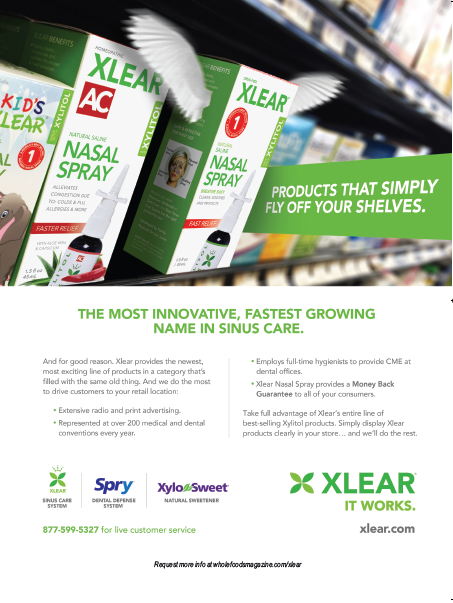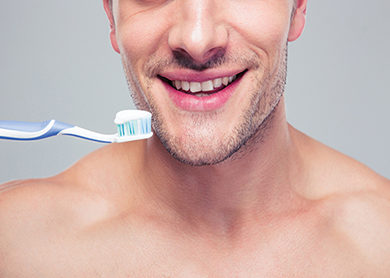Considering how often you brush, rinse and floss, it makes sense for shoppers to know the risks associated with questionable ingredients found in many conventional oral care products. Consumers are starting to rethink their dental routine, and here is what they should know about their options.
Fluoride: How It Helps and Hurts
Pros. Fluoride has been praised for its ability to prevent oral decay by aiding in the hardening of tooth enamel, and is recommended by the American Dental Association (ADA) for proper dental hygiene (1). A 2013 study concluded that fluoride also disrupts bacterial adhesion to teeth, preventing the acid formation that causes cavities (1). Due to these benefits, fluoride has been added to various oral care products, natural and conventional alike, as well as public drinking water.
Recently, the ADA started recommending the use of fluoridated toothpaste (in amounts the size of a grain of rice) in babies as soon as the first tooth appears.
 Cons. Not all shoppers feel comfortable ingesting fluoride, however. Older studies conducted by the National Toxicology Program using both rats and humans link the risk of fluoride to carcinogenic activity and bone tumors (2). However, it must be noted that more specialized research is necessary to solidify this finding (2). In fact, later research from the National Cancer Institute found no association between the mineral and cancer.
Cons. Not all shoppers feel comfortable ingesting fluoride, however. Older studies conducted by the National Toxicology Program using both rats and humans link the risk of fluoride to carcinogenic activity and bone tumors (2). However, it must be noted that more specialized research is necessary to solidify this finding (2). In fact, later research from the National Cancer Institute found no association between the mineral and cancer.
Fluoride has also been associated with bone fractures in some epidemiology research (2). One study found that populations with high fluoride intake had more occurrences of certain bone fractures than others, though additional research is needed to establish a cause and effect relationship (2). Other potential issues associated with the ingestion of fluoride are fluorosis (i.e., tooth discoloration caused by excessive amounts of fluoride interrupting the development of tooth enamel), hormonal imbalances, muscle dysfunction and more (3).
Since there are so many opinions about the use of fluoride, it is important for shoppers to draw their own conclusions using the available information.
What to Avoid
Triclosan. Commonly found in products like toothpaste and hand soap, the antibacterial chemical triclosan may come with a biological cost. Despite initial reports suggesting triclosan posed no danger to health, the U.S. Food and Drug Administration has started reevaluating the use of triclosan and similar chemicals in soaps and other personal care products (4). New studies suggest triclosan and its counterparts may be responsible for the rise in antibiotic resistance and hormonal imbalance (4). In May 2014, Minnesota became the first state to ban the use of triclosan (implementation starts in 2017); Canadian officials are also advocating for the banning of triclosan and the use of safer substitutes (4).
Another study done by the American Chemical Society in 2014 found that triclosan promotes human breast cancer cell growth in a lab setting, as well as breast cancer tumors in mice (5). First registered as a pesticide in 1969, triclosan has also been linked to heart disease, heart failure, muscle dysfunction and environmental contamination (6).
Saccharin and aspartame. These chemicals act as artificial sweeteners and can cause health problems in some consumers (19).
Added colors. The practice of adding colors to oral care products has no benefit to health. Dyes such as FD&C blue dye No. 2 have been linked to developmental and learning problems, in addition to allergic reactions (20).
Sodium lauryl sulfate. This common chemical responsible for the lathering effect in many toothpastes can act as an irritant that supports the growth of canker sores, even when derived from natural sources (7). Therefore, natural companies that use this ingredient tend to use small amounts that are enough to do its job, but will not cause irritation (8).
Natural Ingredients and Their Benefits
Baking soda. Known as a classic natural teeth whitener, baking soda is a great oral defense against plague. It is said to neutralize acids in the mouth that cause cavities (9).
Tea tree oil. Thanks to its antibacterial and antifungal properties, tea tree oil can aid in maintaining fresh breath and supporting good dental hygiene (10).
Colloidal silver. This well-documented natural antibiotic can help maintain oral health when properly used under the guidance of a health official (11).
Activated charcoal. Recognized for its ability to eliminate toxins, activated charcoal has been found to act as a natural teeth-whitening agent (12).
Aloe. The healing power of aloe vera can benefit oral health. The Academy of General Dentistry advocates that using aloe vera tooth gel can help maintain a disease-free mouth due to its antibacterial abilities (13).
Neem. In its extract form, studies show that neem is effective in the treatment of gum disease, maintenance of fresh breath, cavity prevention and reducing plaque (14).
Cranberry. Some evidence supports the use of cranberry for dental caries and periodontal disease, since it disturbs bacterial adhesion in the mouth (15).
Xylitol and Why You Should Use It
In addition to its use as a diabetic-friendly alternative to refined sugar, xylitol also offers dental benefits (16). Long-term studies have shown that using oral care products containing xylitol, or chewing xylitol gum and mints after meals, can aid in the prevention of tooth decay, cavities, plaque and help repair enamel damage (16). These benefits can be credited to xylitol’s ability to help increase saliva production, as well as maintain a healthy pH balance in the mouth (16). Kept within the consumption guidelines of less than 15 g per day, xylitol makes a great addition to oral care efforts (16). Any questions should be discussed with a healthcare provider.
Homeopathic Teething Tablets: Do They Work?
Looking for a natural way to soothe a teething baby? Homeopathic teething tablets may be just the thing to help with the inflammation and discomfort of incoming teeth. They dissolve instantly and providing fast relief from achy red gums minus the use of synthetic ingredients (16).
Most conventional teething medications contain artificial dyes, flavors, preservatives and a risky anesthetic called benzocaine (17). FDA has linked benzocaine to a rare blood disorder called methemoglobinemiam, which can be life-threatening (18). Consumers might want to rethink giving children younger than two years old any products that contain benzocaine due to higher instances of methemoglobinemia within that age range (18). For parents who want to avoid these ingredients to calm hurting gums, homeopathic teething medicines are great options all around. WF
References
1. American Chemical Society, “New evidence on how fluoride fights tooth decay,”http://www.sciencedaily.com/releases/2013/05/130501112855.htm
2. The Office of Disease Prevention and Health Promotion, “Major Findings,” http://www.health.gov/environment/reviewoffluoride/majfind.htm
3. Mercola, “10 Facts About Fluoride You Need to Know,” http://articles.mercola.com/sites/articles/archive/2013/04/30/water-fluoridation-facts.aspx
4. CBC News, “Ban antibacterials triclosan and triclocarban, report says,” http://www.cbc.ca/news/technology/ban-antibacterials-triclosan-and-triclocarban-report-says-1.2703095
5. American Chemical Society, “In lab tests, the antimicrobial ingredient triclosan spurs growth of breast cancer cells,” http://www.sciencedaily.com/releases/2014/04/140423102756.htm
6. Mercola, “Triclosan: The Soap Ingredient You Should Never Use -- But 75% of Households Do,” http://articles.mercola.com/sites/articles/archive/2012/08/29/triclosan-in-personal-care-products.aspx
7. Good Housekeeping, “The Truth About Natural Toothpaste,” http://www.goodhousekeeping.com/health/wellness/a18438/natural-toothpaste-ingredients-0307/
8. Tom’s of Maine, “Sodium Lauryl Sulfate,” http://www.tomsofmaine.com/ingredients/overlay/sodium-lauryl-sulfate
9. WebMD, “5 Things You Didn’t Know About Your Teeth,” http://www.webmd.com/oral-health/features/5-things-you-didnt-know-about-your-teeth
10. RDH Magazine, “Tea tree oil – just a fad?” http://www.rdhmag.com/articles/print/volume-26/issue-8/columns/mind-body-spirit/tea-tree-oil-just-a-fad.html
11. Mercola, “New Guidelines for Safe Usage of Colloidal Silver,” http://articles.mercola.com/sites/articles/archive/2009/02/07/new-guidelines-released-for-safe-usage-of-colloidal-silver-supplements.aspx
12. My Magic Mud, http://www.mymagicmud.com/faq/Academy of General Dentistry, “Tooth Gel: Healing Power Of Aloe Vera Proves Beneficial For Teeth And Gums, Too,” http://www.sciencedaily.com/releases/2009/07/090717150300.htm
13. Discover Neem, “Neem for Gum Disease and Oral Care,” http://www.discoverneem.com/neem-gum-disease.html
14. The Canadian Dental Association, “Cranberry Polyphenols: Potential Benefits for Dental Caries and Periodontal Disease,” http://www.jcda.ca/article/a130
15. Xylitol, “Why Use Xylitol,” http://xylitol.org/about-xylitol/why-use-xylitol
16. Hyland’s, “ Hyland’s Baby Teething Tablets,” http://hylands.ca/products/teething.php
17. WebMD, “FDA Warns About Teeth Medication,” http://www.webmd.com/parenting/baby/news/20110505/fda-warns-about-teething-medication
18. M.W. Smith, “Stevia and Sugar Substitutes,” http://www.webmd.com/diet/stevia-sugar-substitutes, accessed 8/28/15.
19. M. Oaklander, “New fear about food dyes,” http://www.foxnews.com/health/2013/01/16/new-fear-about-food-dyes, accessed 8/28/15.
Published in WholeFoods Magazine, October 2015(online 9/3/2015)









